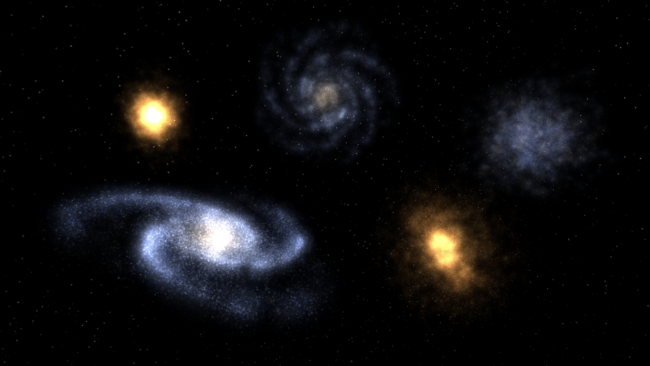Galaxies & Grids | Dev Update #5


For this developer update, we’re going to take a little break from looking at our work on Surface Grids & Lasers to turn our attention on the upcoming new galaxies (these are a work-in-progress and are not yet available in Universe Sandbox).
You can check out Dev Update #1, Dev Update #2, Dev Update #3, and Dev Update #4 for a more in-depth look at Surface Grids & Lasers.
Keep in mind this is a development log for work-in-progress features. Anything discussed or shown may not be representative of the final release states for these features.
A Whole New World (of Galaxies)
We’ve been saying for a while now — and the community has been making sure to regularly remind us — that the state of galaxies in Universe Sandbox has not been so good. There was a pretty good looking preset simulation for a Milky Way & Andromeda Collision, but when it came to adding any type of galaxy to another simulation, you were left wondering why they all looked like the same amorphous blob, why they were difficult to work with, and what exactly all those red dots were.
Case in point, here’s a Milky Way added to a simulation with the old galaxies:

And here’s a new Milky Way:

We hope you agree this is a massive visual improvement. But there’s more than just beautification happening. Here are the major parts that make up the new galaxies:
1. Black holes & nebulae
- A galaxy is a combination of a black hole and a number of surrounding nebulae (each of which represents a group of stars)
2. Individual, editable properties
- Select and edit properties for black holes, individual nebulae, or the whole galaxy
- Each includes typical object properties like mass, radius, rotation, position, velocity, etc.
- Unique whole galaxy properties include galaxy type (elliptical, spiral, and irregular), elliptical B/A ratio, spiral number of arms, and pitch angle
3. Accurate motion
- Orbital elements of the nebulae are set by galaxy type and determine overall motion
- Nebulae positions and velocities change as galaxy type and type-related properties (B/A ratio, pitch angle, etc) are edited
- Galaxies in isolation will retain proper motion and shape over time
- Galaxies perturbed by massive bodies (like another galaxy or an isolated, supermassive black hole) become irregular type galaxies
4. Data-driven visuals
- Nebulae have a Gas Fraction property that represents the ratio of gas (the material available for making stars) to stars as well as an average temperature property
- Combined, these properties result in red/yellow elliptical galaxies, bluer spiral arms, and a visible increase in blue star production in colliding galaxies
- Nebulae also have a Dust Fraction property that represents the ratio of dust (opaque material) to gas and stars (luminous material); dust traces spiral arms and blocks light from the galaxy when viewed edge-on

GIF: Editable properties and the different visuals for different types of galaxies.
5. Procedural generation
- Create a randomly generated spiral galaxy, elliptical galaxy, or irregular galaxy
6. Support for trails & orbits
- Show trails or orbits for individual nebulae, which provides insight into realistic galaxy motion
7. No more dark matter
- Proper dark matter simulation is very complicated and we weren’t satisfied with its implementation in our last galaxy model
- In the future we’ll have a more in-depth explanation of this in a blog post from Erika, Universe Sandbox astrophysicist and developer behind the new galaxies

Image: A collection of randomly generated spiral, elliptical, and irregular galaxies.
The Future of Galaxies
We’re very happy with the status of galaxies right now. Before we can release them, there are some minor changes we need to make with the interface and other miscellaneous areas around the edges, and we still need a round or three of testing and bug fixes. But the simulation itself is in great shape.
When it comes to simulation features in Universe Sandbox, though, we almost never consider them a done deal. There are always improvements we have in mind for making them more realistic, performant, and fun to experiment with.
After the initial release of these new galaxies we’ll likely take a break from them for a bit. But here are some improvements and additions we’d love to explore more in the future:
- Barred spiral galaxies
- Visual representation of accurately-timed supernova flashes
- Values to show estimated numbers of stars in nebulae and total values in galaxy groups
- Randomization parameters for more “natural-looking” galaxies
- Run as fluid/SPH (smoothed-particle hydrodynamics) simulation
Surface Grids Sidebar
We’re hyped on galaxies and hope you are, too. Fingers crossed that the last stretch of finishing out this feature goes smoothly and quickly!
But of course, we’re also still working on Surface Grids & Lasers, so here’s a small update on those features:
Chris has been working on the saving and loading system for Surface Grids. This is a little less straightforward than it had been for saving and loading objects and simulations, due to the sheer amount of data that can be included with a lot of objects using the new Grids system.
Jenn has continued with making an accurate water vapor model, with the challenge of creating this accurately and performatively without single-handedly developing Weather Simulator 2020.
Georg has been applying his shader magic to galaxies and helping with proper rendering for Universe Sandbox on Magic Leap. Now that the graphics work for both of those are mostly finished, he’s got his eye on Surface Grids again as he continues to shape water data and heightmaps to get nice looking coastlines on Earth and other planets.
Stay tuned for another announcement about an opt-in version of Universe Sandbox that includes these new galaxies — we need to squash some of the nastier bugs still, but we’re getting close.
